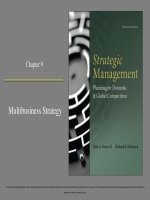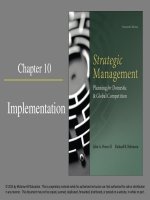Operations management 12th stevenson ch05 strategic capacity planning for products and services
Bạn đang xem bản rút gọn của tài liệu. Xem và tải ngay bản đầy đủ của tài liệu tại đây (717.22 KB, 61 trang )
Chapter 5
Strategic
Capacity
Planning for
Products and
Services
McGraw-Hill/Irwin
Copyright © 2012 by The McGraw-Hill Companies, Inc. All rights reserved.
Learning Objective: Chapter 5
You should be able to:
1. Summarize the importance of capacity
2.
3.
4.
5.
planning
Discuss ways of defining and measuring
capacity
Describe the determinants of effective
capacity
Discuss the major considerations related to
developing capacity alternatives
Briefly describe approaches that are useful for
evaluating capacity alternatives
Instructor Slides
5-2
Capacity Planning
Capacity
The upper limit or ceiling on the load that an
operating unit can handle
Capacity needs include
Equipment
Space
Employee skills
Instructor Slides
5-3
Strategic Capacity Planning
Goal
To achieve a match between the long-term
supply capabilities of an organization and the
predicted level of long-term demand
Overcapacity operating costs that are too high
Undercapacity strained resources and possible loss
of customers
Instructor Slides
5-4
Capacity Planning Questions
Key Questions:
What kind of capacity is needed?
How much is needed to match demand?
When is it needed?
Related Questions:
How much will it cost?
What are the potential benefits and risks?
Are there sustainability issues?
Should capacity be changed all at once, or through
several smaller changes
Can the supply chain handle the necessary changes?
Instructor Slides
5-5
Production Capacity Planning
Labor
Capacity
Equipment
Capacity
Packaging
Capacity
Material
Receiving
Capacity
Production
Capacity
Equipment
Maintenance
Capacity
Facility
Capacity
Inventory
Storage
Capacity
Sales Force
Capacity
Measures of Capacity
We measure the capacity of a plant,
machine department, worker,
hospital, etc., either
in terms of output (number of units or
number of pounds manufactured) or
in terms of input (e.g. number of machine
hours, machines, labor hours, …).
A major function of capacity planning
is to match the capacity of the
machine or facility with the demand
for the products of the firm.
Capacity Planning Horizons
Capacity planning can be classified into
three planning horizons:
Long range planning horizons of one year or
longer to provide sufficient time to build a
new facility, to expand the existing facility or
to move to a new facility due to expected
changes in demand.
Medium range planning horizon ranges
approximately from one month and less than
a year. At this level of planning, decisions or
activities include acquisition of a major piece
of machinery and subcontracting.
Short range planning horizon covers capacity
planning activities on a daily or a weekly
basis and are generated as a result of
disaggregation of the long or medium range
capacity plans. These activities include
machine loading and detailed production
Capacity Planning
Output rate is uncertain because:
Employee absences
Equipment breakdown
Vacations
Material delivery delays and shortages
Quality problems and rework
Capacity Decisions Are Strategic
Capacity decisions
1. impact the ability of the organization to meet future
demands
2. affect operating costs
3. are a major determinant of initial cost
4. often involve long-term commitment of resources
5. can affect competitiveness
6. affect the ease of management
7. have become more important and complex due to
globalization
8. need to be planned for in advance due to their
consumption of financial and other resources
Instructor Slides
5-10
Capacity
Design capacity
Maximum output rate or service capacity an operation,
process, or facility is designed for
Effective capacity
Design capacity minus allowances such as personal time,
maintenance, and scrap
Actual output
Rate of output actually achieved--cannot
exceed effective capacity.
Instructor Slides
5-11
Defining and Measuring Capacity
Measure capacity in units that do not
require updating
Why is measuring capacity in dollars problematic?
Two useful definitions of capacity
Design capacity
The maximum output rate or service capacity an
operation, process, or facility is designed for
Effective capacity
Design capacity minus allowances such as personal
time and maintenance
Instructor Slides
5-12
Measuring System Effectiveness
Actual output
The rate of output actually achieved
It cannot exceed effective capacity
Efficiency
Utilization
actual output
Efficiency
effective capacity
actual output
Utilization
designcapacity
Measured as percentages
Instructor Slides
5-13
Example– Efficiency and Utilization
Design Capacity = 50 trucks per day
Effective Capacity = 40 trucks per day
Actual Output = 36 trucks per day
actual output
36
Efficiency
90%
effective capacity 40
actual output
36
Utilization
72%
designcapacity 50
Instructor Slides
5-14
Determinants of Effective Capacity
Facilities
Product and service factors
Process factors
Human factors
Policy factors
Operational factors
Supply chain factors
External factors
Instructor Slides
5-15
Capacity Strategies
Leading
Build capacity in anticipation of future demand increases
Following
Build capacity when demand exceeds current capacity
Tracking
Similar to the following strategy, but adds capacity in
relatively small increments to keep pace with increasing
demand
Strategy Formulation
Strategies are typically based on
assumptions and predictions about:
Long-term demand patterns
Technological change
Competitor behavior
Instructor Slides
5-17
Capacity Cushion
Capacity Cushion
Extra capacity used to offset demand
uncertainty
Capacity cushion = 100% - Utilization
Capacity cushion strategy
Organizations that have greater demand
uncertainty typically have greater capacity cushion
Organizations that have standard products and
services generally have greater capacity cushion
Instructor Slides
5-18
Steps in Capacity Planning
1.
Estimate future capacity requirements
2.
Evaluate existing capacity and facilities; identify gaps
3.
Identify alternatives for meeting requirements
4.
Conduct financial analyses
5.
Assess key qualitative issues
6.
Select the best alternative for the long term
7.
Implement alternative chosen
8.
Monitor results
Instructor Slides
5-19
Forecasting Capacity Requirements
Long-term considerations relate to overall
level of capacity requirements
Require forecasting demand over a time horizon
and converting those needs into capacity
requirements
Short-term considerations relate to probable
variations in capacity requirements
Less concerned with cycles and trends than
with seasonal variations and other variations
from average
Instructor Slides
5-20
Calculating Processing
Requirements
Calculating processing requirements requires
reasonably accurate demand forecasts,
standard processing times, and available work
time k
pD
i
N R i 1
i
T
where
N R number of required machines
pi standard processingtime for product i
Di demand for product i during the planning horizon
T processingtime available during the planning horizon
Instructor Slides
5-21
Calculating Processing Requirements
Standard
processing time
per unit (hr.)
Product
Annual
Demand
Processing time
needed (hr.)
#1
400
5.0
2,000
#2
300
8.0
2,400
#3
700
2.0
1,400
5,800
If annual capacity is 2000 hours, then we need three machines to handle the
required volume: 5,800 hours/2,000 hours = 2.90 machines
5-22
Calculating Processing
Requirements
If a department works one eight hour
shift, 250 days per year how many
machines are needed?
(5,800)/(8 X 250) = 2.9 or 3 machines
Service Capacity Planning
Service capacity planning can present a
number of challenges related to:
The need to be near customers
Convenience
The inability to store services
Cannot store services for consumption later
The degree of demand volatility
Volume and timing of demand
Time required to service individual customers
Instructor Slides
5-24
Demand Management Strategies
Strategies used to offset capacity limitations
and that are intended to achieve a closer
match between supply and demand
Pricing
Promotions
Discounts
Other tactics to shift demand from peak
periods into slow periods
Instructor Slides
5-25









